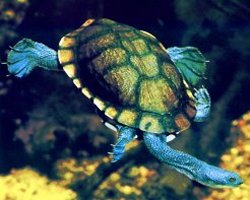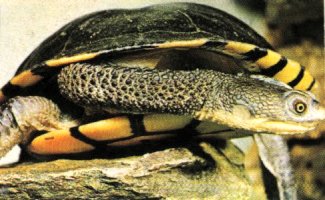TESTUGGINE SNAKE NECK

Chelodina longicollis, said "Testuggine snake neck", diffused in Australia.
It dictates "to Testuggine snake neck", diffused nellAustralia south orients them, above all in the water system of the Murray River.
The carapace pu to catch up a length of approximately 30 cm, which it goes added the longest neck that lanimale it takes advantage of in order to breathe remaining submergeeed and leaving to emerge the head or also only the narici. Its habits are spiccatamente aquatic (attend calm handles of the rivers, lagos, ponds and swampy zones in kind) but it does not scorn long pauses allasciutto for healthy sun baths. It belongs to the family of the Chelidae, sottordine Pleurodira.
It has diurnal habits and spiccatamente discreetly active. Nutre in nature of frogs, girini, aquatic bugs us and also fish, also if these last ones strongly seem not to be the "plate" of its diet. In cattivit chip ax easy meat, pezzetti of polpa of fish, the so-called the "fruits of sea", gamberetti you live or scongelati and great part of the alimony produced for the testuggini aquatic and large fish, it is scongelati (by far devout appreciate) is freezes-dry or buckets to you.

Breeding
breeders not difficult but c need of a large paludario with a such aquatic zone to offer wide space for the swim: at least 100-120 liters of effective capienza (if than better devout) for one brace. The emerged zone pu to be instead relatively modest poich the "neck of snake" passes great part of its time nellacqua.
SUGGESTED BREEDINGS by MENANDPETS.COM
No breeding to signal
if you want to know like signaling yours, contacts: marketing@inseparabile.it
REPRODUCTION
The deposition of eggs in nature happens in November (in the month cio in which, nellemisfero austral from which it comes, the spring is developed). News is not had on positive reproductions in cattivit, but it presumes that they happen however in spring (in this case in "the our" spring). Every female places between 10 and 15 eggs that schiudono after approximately 18 weeks.